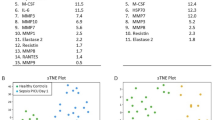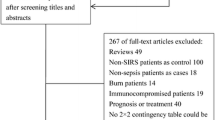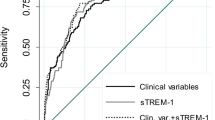Abstract
Purpose
Sepsis and non-septic systemic inflammatory response syndrome (SIRS) are the same syndromes, differing by their cause, sepsis being secondary to microbial infection. Microbiological tests are not enough to detect infection early. While more than 50 biomarkers have been proposed to detect infection, none have been repeatedly validated.
Aim
To assess the accuracy of circulating biomarkers to discriminate between sepsis and non-septic SIRS.
Methods
The CAPTAIN study was a prospective observational multicenter cohort of 279 ICU patients with hypo- or hyperthermia and criteria of SIRS, included at the time the attending physician considered antimicrobial therapy. Investigators collected blood at inclusion to measure 29 plasma compounds and ten whole blood RNAs, and—for those patients included within working hours—14 leukocyte surface markers. Patients were classified as having sepsis or non-septic SIRS blindly to the biomarkers results. We used the LASSO method as the technique of multivariate analysis, because of the large number of biomarkers.
Results
During the study period, 363 patients with SIRS were screened, 84 having exclusion criteria. Ninety-one patients were classified as having non-septic SIRS and 188 as having sepsis. Eight biomarkers had an area under the receiver operating curve (ROC-AUC) over 0.6 with a 95% confidence interval over 0.5. LASSO regression identified CRP and HLA-DRA mRNA as being repeatedly associated with sepsis, and no model performed better than CRP alone (ROC-AUC 0.76 [0.68–0.84]).
Conclusions
The circulating biomarkers tested were found to discriminate poorly between sepsis and non-septic SIRS, and no combination performed better than CRP alone.


Similar content being viewed by others
References
Levy MM, Fink MP, Marshall JC et al (2003) 2001 SCCM/ESICM/ACCP/ATS/SIS international sepsis definitions conference. Crit Care Med 31:1250–1256. https://doi.org/10.1097/01.CCM.0000050454.01978.3B
Singer M, Deutschman CS, Seymour CW et al (2016) The third international consensus definitions for sepsis and septic shock (Sepsis-3). JAMA 315:801–810. https://doi.org/10.1001/jama.2016.0287
Liu V, Escobar GJ, Greene JD et al (2014) Hospital deaths in patients with sepsis from 2 independent cohorts. JAMA 312:90–92. https://doi.org/10.1001/jama.2014.5804
Kumar A, Ellis P, Arabi Y et al (2009) Initiation of inappropriate antimicrobial therapy results in a fivefold reduction of survival in human septic shock. Chest 136:1237–1248. https://doi.org/10.1378/chest.09-0087
Rhodes A, Evans LE, Alhazzani W et al (2017) Surviving Sepsis Campaign: international guidelines for management of sepsis and septic shock: 2016. Intensive Care Med 43:304–377. https://doi.org/10.1007/s00134-017-4683-6
Seymour CW, Liu VX, Iwashyna TJ et al (2016) Assessment of clinical criteria for sepsis: for the third international consensus definitions for sepsis and septic shock (Sepsis-3). JAMA 315:762–774. https://doi.org/10.1001/jama.2016.0288
Parlato M, Cavaillon J-M (2015) Host response biomarkers in the diagnosis of sepsis: a general overview. Methods Mol Biol 1237:149–211. https://doi.org/10.1007/978-1-4939-1776-1_15
Andriolo BN, Andriolo RB, Salomão R, Atallah ÁN (2017) Effectiveness and safety of procalcitonin evaluation for reducing mortality in adults with sepsis, severe sepsis or septic shock. Cochrane Datab Syst Rev 1:CD010959. https://doi.org/10.1002/14651858.cd010959.pub2
Gros A, Roussel M, Sauvadet E et al (2012) The sensitivity of neutrophil CD64 expression as a biomarker of bacterial infection is low in critically ill patients. Intensive Care Med 38:445–452. https://doi.org/10.1007/s00134-012-2483-6
Gibot S, Béné MC, Noel R et al (2012) Combination biomarkers to diagnose sepsis in the critically ill patient. Am J Respir Crit Care Med 186:65–71. https://doi.org/10.1164/rccm.201201-0037OC
ten Oever J, Tromp M, Bleeker-Rovers CP et al (2012) Combination of biomarkers for the discrimination between bacterial and viral lower respiratory tract infections. J Infect 65:490–495. https://doi.org/10.1016/j.jinf.2012.08.004
Oliveira CF, Botoni FA, Oliveira CRA et al (2013) Procalcitonin versus C-reactive protein for guiding antibiotic therapy in sepsis: a randomized trial. Crit Care Med 41:2336–2343. https://doi.org/10.1097/CCM.0b013e31828e969f
Oved K, Cohen A, Boico O et al (2015) A novel host-proteome signature for distinguishing between acute bacterial and viral infections. PLoS One 10:e0120012. https://doi.org/10.1371/journal.pone.0120012
McHugh L, Seldon TA, Brandon RA et al (2015) A molecular host response assay to discriminate between sepsis and infection-negative systemic inflammation in critically ill patients: discovery and validation in independent cohorts. PLoS Med 12:e1001916. https://doi.org/10.1371/journal.pmed.1001916
Quenot J-P, Luyt C-E, Roche N et al (2013) Role of biomarkers in the management of antibiotic therapy: an expert panel review II: clinical use of biomarkers for initiation or discontinuation of antibiotic therapy. Ann Intensive Care 3:21. https://doi.org/10.1186/2110-5820-3-21
Tang BMP, Eslick GD, Craig JC, McLean AS (2007) Accuracy of procalcitonin for sepsis diagnosis in critically ill patients: systematic review and meta-analysis. Lancet Infect Dis 7:210–217. https://doi.org/10.1016/S1473-3099(07)70052-X
von Elm E, Altman DG, Egger M et al (2007) The Strengthening the Reporting of Observational Studies in Epidemiology (STROBE) statement: guidelines for reporting observational studies. Ann Intern Med 147:573–577
Cohen J, Vincent J-L, Adhikari NKJ et al (2015) Sepsis: a roadmap for future research. Lancet Infect Dis 15:581–614. https://doi.org/10.1016/S1473-3099(15)70112-X
Le Gall JR, Lemeshow S, Saulnier F (1993) A new simplified acute physiology score (SAPS II) based on a European/North American multicenter study. JAMA 270:2957–2963
Vincent JL, de Mendonça A, Cantraine F et al (1998) Use of the SOFA score to assess the incidence of organ dysfunction/failure in intensive care units: results of a multicenter, prospective study. Working group on “sepsis-related problems” of the European Society of Intensive Care Medicine. Crit Care Med 26:1793–1800
Hanley JA, McNeil BJ (1983) A method of comparing the areas under receiver operating characteristic curves derived from the same cases. Radiology 148:839–843. https://doi.org/10.1148/radiology.148.3.6878708
Tibshirani R (1996) Regression shrinkage and selection via the lasso. J R Stat Soc Ser B Methodol 58:267–288
Rubin DB (2004) Multiple imputation for nonresponse in surveys. Wiley, Chichester
Musoro JZ, Zwinderman AH, Puhan MA et al (2014) Validation of prediction models based on lasso regression with multiply imputed data. BMC Med Res Methodol 14:116. https://doi.org/10.1186/1471-2288-14-116
Messer J, Eyer D, Donato L et al (1996) Evaluation of interleukin-6 and soluble receptors of tumor necrosis factor for early diagnosis of neonatal infection. J Pediatr 129:574–580
Kofoed K, Andersen O, Kronborg G et al (2007) Use of plasma C-reactive protein, procalcitonin, neutrophils, macrophage migration inhibitory factor, soluble urokinase-type plasminogen activator receptor, and soluble triggering receptor expressed on myeloid cells-1 in combination to diagnose infections: a prospective study. Crit Care 11:R38. https://doi.org/10.1186/cc5723
Harbarth S, Holeckova K, Froidevaux C et al (2001) Diagnostic value of procalcitonin, interleukin-6, and interleukin-8 in critically ill patients admitted with suspected sepsis. Am J Respir Crit Care Med 164:396–402. https://doi.org/10.1164/ajrccm.164.3.2009052
Sager R, Wirz Y, Amin D et al (2017) Are admission procalcitonin levels universal mortality predictors across different medical emergency patient populations? Results from the multi-national, prospective, observational TRIAGE study. Clin Chem Lab Med 55:1873–1880. https://doi.org/10.1515/cclm-2017-0144
Ruokonen E, Ilkka L, Niskanen M, Takala J (2002) Procalcitonin and neopterin as indicators of infection in critically ill patients. Acta Anaesthesiol Scand 46:398–404
Heffner AC, Horton JM, Marchick MR, Jones AE (2010) Etiology of illness in patients with severe sepsis admitted to the hospital from the emergency department. Clin Infect Dis 50:814–820. https://doi.org/10.1086/650580
Hranjec T, Rosenberger LH, Swenson B et al (2012) Aggressive versus conservative initiation of antimicrobial treatment in critically ill surgical patients with suspected intensive-care-unit-acquired infection: a quasi-experimental, before and after observational cohort study. Lancet Infect Dis 12:774–780. https://doi.org/10.1016/S1473-3099(12)70151-2
Contou D, Roux D, Jochmans S et al (2016) Septic shock with no diagnosis at 24 h: a pragmatic multicenter prospective cohort study. Crit Care 20:360. https://doi.org/10.1186/s13054-016-1537-5
Alberti C, Brun-Buisson C, Burchardi H et al (2002) Epidemiology of sepsis and infection in ICU patients from an international multicentre cohort study. Intensive Care Med 28:108–121. https://doi.org/10.1007/s00134-001-1143-z
Tabah A, Koulenti D, Laupland K et al (2012) Characteristics and determinants of outcome of hospital-acquired bloodstream infections in intensive care units: the EUROBACT International Cohort Study. Intensive Care Med 38:1930–1945. https://doi.org/10.1007/s00134-012-2695-9
Timmermans K, Kox M, Vaneker M et al (2016) Plasma levels of danger-associated molecular patterns are associated with immune suppression in trauma patients. Intensive Care Med 42:551–561. https://doi.org/10.1007/s00134-015-4205-3
Horvath GL, Schrum JE, De Nardo CM, Latz E (2011) Intracellular sensing of microbes and danger signals by the inflammasomes. Immunol Rev 243:119–135. https://doi.org/10.1111/j.1600-065X.2011.01050.x
Parlato M, Souza-Fonseca-Guimaraes F, Philippart F et al (2014) CD24-triggered caspase-dependent apoptosis via mitochondrial membrane depolarization and reactive oxygen species production of human neutrophils is impaired in sepsis. J Immunol 1950 192:2449–2459. https://doi.org/10.4049/jimmunol.1301055
Acknowledgements
The authors thank URC-CIC Paris Descartes Necker/Cochin (Laurence Lecomte-Raclet and Elsa Bournaud) for implementation, monitoring, and data management of the study.
Members of the Combined Approach for The eArly diagnosis of INfection in sepsis (CAPTAIN) study group: Sébastien Jacqmin, Didier Journois, Alix Lagrange, Gabrielle de Pinot de Villechenon (Hôpital Européen Georges Pompidou, AP-HP—Université Paris Descartes, Service d’Anesthésie-Réanimation), Nadia Aissaoui, Jean-Luc Diehl, Emmanuel Guerot, Marion Venot (Hôpital Européen Georges Pompidou, AP-HP—Université Paris Descartes, Service de Réanimation Médicale), Olfa Hamzaoui, Dominique Prat, Benjamin Sztrymf (Hôpital Antoine Béclère, AP-HP—Université Paris Sud, Clamart), Djillali Annane, Virginie Maxime, Andrea Polito (Hôpital Raymond Poincaré, AP-HP—Université Paris Ile de France Ouest, Service de Réanimation Médico-chirurgicale), Belaïd Bouhemad, Cédric Bruel, Frédéric Ethuin, Julien Fournier, Maïté Garrouste-Orgeas, Charles Gregoire, Nicolas Lau, Benoît Misset, François Philippart (Groupe Hospitalier Paris Saint Joseph, Service de Réanimation), Jean-Pierre Bedos, Pierrick Crosnier, Virginie Laurent, Sybille Merceron (Hôpital André Mignot, Versailles, Service de Réanimation médico-chirurgicale), Elsa Bournaud, Laurence Lecomte, Jean-Marc Treluyer, (Hôpital Cochin, AP-HP—Université Paris Descartes, Unité de Recherche Clinique), Alexandre Pachot, Javier Yugueros-Marcos, Laurent Esteve, Sophie Blein, Virginie Moucadel (bioMérieux, Lyon & Grenoble), Myriam Ben Boutieb, Alexandra Rouquette, Joël Coste (Hôpital Hotel-Dieu, AP-HP—Université Paris Descartes, Unité de Biostatistique et d’Epidémiologie), Minou Adib-Conguy, Jean-Marc Cavaillon, Catherine Fitting, Marianna Parlato, Virginie Puchois, Fernando Souza-Fonseca-Guimaraes (Institut Pasteur, Paris, Unit Cytokines & Inflammation).
Funding
Grant from the Programme Hospitalier de Recherche Clinique of the French Ministry of Health (PHRC AOM 09143) and from the Institut Mérieux-Institut Pasteur collaborative research partnership. The study was sponsored by the Département de la Recherche Clinique et du Développement de l’Assistance Publique-Hôpitaux de Paris. This project was part of Advanced Diagnostics for New Therapeutic Approaches, a program dedicated to personalized medicine, coordinated by Mérieux Alliance and supported by the French public agency, OSEO.
Author information
Authors and Affiliations
Consortia
Contributions
AR, LE, SB, VM, JMC, and BM had full access to all the data in the study and take responsibility for the integrity of the data and the accuracy of the data analysis. Study concept and design: FP, AR, AP, JMC, and BM. Acquisition of data: MP, FP, CF, VP, VM, JPB, DJ, OH, DA, JLD, LL, JMT. Access to data, analysis, and interpretation: MP, FP, AR, LE, SB, VM, MBB, AP, MAC, JMC, and BM. Drafting of the manuscript: FP, MP, AR, SB, VM, JMC, and BM. Critical revision of the manuscript for important intellectual content: MP, FP, AR, SB, VM, DA, JMC, and BM. Statistical analysis: AR, MBB, LE, and SB. Obtained funding: AP, JMC, and BM. Administrative, technical, or material support: CF and JMT.
Corresponding author
Ethics declarations
Conflicts of interest
Moucadel, Estève, and Pachot are employed by bioMérieux SA, a private company specializing in in vitro diagnostics. The authors declare no other potential conflicts of interest in relation to the subject of the present manuscript.
Additional information
The members of the CAPTAIN study team are provided in the Acknowledgements section.
Minou Adib-Conquy: Deceased.
Electronic supplementary material
Below is the link to the electronic supplementary material.
Rights and permissions
About this article
Cite this article
Parlato, M., Philippart, F., Rouquette, A. et al. Circulating biomarkers may be unable to detect infection at the early phase of sepsis in ICU patients: the CAPTAIN prospective multicenter cohort study. Intensive Care Med 44, 1061–1070 (2018). https://doi.org/10.1007/s00134-018-5228-3
Received:
Accepted:
Published:
Issue Date:
DOI: https://doi.org/10.1007/s00134-018-5228-3




